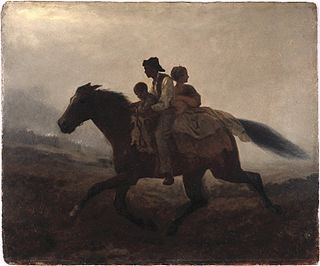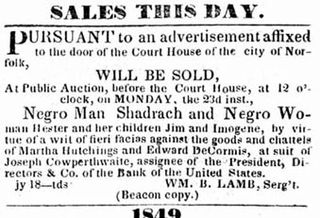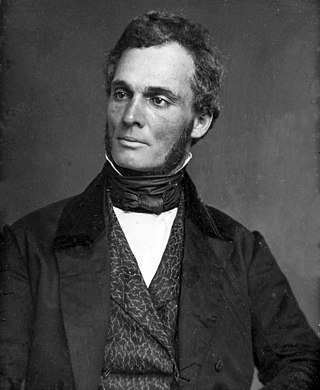
The Underground Railroad was a network of secret routes and safe houses established in the United States during the early to mid-19th century. It was used by enslaved African Americans primarily to escape into free states and from there to Canada. The network, primarily the work of free African Americans, was assisted by abolitionists and others sympathetic to the cause of the escapees. The slaves who risked capture and those who aided them are also collectively referred to as the passengers and conductors of the Railroad, respectively. Various other routes led to Mexico, where slavery had been abolished, and to islands in the Caribbean that were not part of the slave trade. An earlier escape route running south toward Florida, then a Spanish possession, existed from the late 17th century until approximately 1790. However, the network generally known as the Underground Railroad began in the late 18th century. It ran north and grew steadily until the Emancipation Proclamation was signed by President Abraham Lincoln. One estimate suggests that, by 1850, approximately 100,000 slaves had escaped to freedom via the network.

William Still was an African-American abolitionist based in Philadelphia, Pennsylvania. He was a conductor of the Underground Railroad and was responsible for aiding and assisting at least 649 slaves to freedom towards North. Still was also a businessman, writer, historian and civil rights activist. Before the American Civil War, Still was chairman of the Vigilance Committee of the Pennsylvania Anti-Slavery Society, named the Vigilant Association of Philadelphia. He directly aided fugitive slaves and also kept records of the people served in order to help families reunite.

The Fugitive Slave Act or Fugitive Slave Law was a law passed by the 31st United States Congress on September 18, 1850, as part of the Compromise of 1850 between Southern interests in slavery and Northern Free-Soilers.

In the United States, fugitive slaves or runaway slaves were terms used in the 18th and 19th centuries to describe people who fled slavery. The term also refers to the federal Fugitive Slave Acts of 1793 and 1850. Such people are also called freedom seekers to avoid implying that the enslaved person had committed a crime and that the slaveholder was the injured party.

John Neely Johnson was an American lawyer and politician. He was elected as the fourth governor of California from 1856 to 1858, and later appointed justice to the Nevada Supreme Court from 1867 to 1871. As a member of the American Party, Johnson remains one of only three members of a third party to be elected to the California governorship.

The San Francisco Committee of Vigilance was a vigilante group formed in 1851. The catalyst for its formation was the criminality of the Sydney Ducks gang. It was revived in 1856 in response to rampant crime and corruption in the municipal government of San Francisco, California. The need for extralegal intervention was apparent with the explosive population growth following the discovery of gold in 1848. The small town of about 900 individuals grew to a booming city of over 20,000 very rapidly. This growth in population overwhelmed the previously established law enforcement, and led to the organization of vigilante militia groups.

Shadrach Minkins was an African-American fugitive slave from Virginia who escaped in 1850 and reached Boston. He also used the pseudonyms Frederick Wilkins and Frederick Jenkins. He is known for being freed from a courtroom in Boston after being captured by United States marshals under the Fugitive Slave Act of 1850. Members of the Boston Vigilance Committee freed and hid him, helping him get to Canada via the Underground Railroad. Minkins settled in Montreal, where he raised a family. Two men were prosecuted in Boston for helping free him, but they were acquitted by the jury.

The pre-American Civil War practice of kidnapping into slavery in the United States occurred in both free and slave states, and both fugitive slaves and free negroes were transported to slave markets and sold, often multiple times. There were also rewards for the return of fugitives. Three types of kidnapping methods were employed: physical abduction, inveiglement of free blacks, and apprehension of fugitives. The enslavement, or re-enslavement, of free blacks occurred for 85 years, from 1780 to 1865.

The Boston Vigilance Committee (1841–1861) was an abolitionist organization formed in Boston, Massachusetts, to protect escaped slaves from being kidnapped and returned to slavery in the South. The Committee aided hundreds of escapees, most of whom arrived as stowaways on coastal trading vessels and stayed a short time before moving on to Canada or England. Notably, members of the Committee provided legal and other aid to George Latimer, Ellen and William Craft, Shadrach Minkins, Thomas Sims, and Anthony Burns.

William Cooper Nell was an American abolitionist, journalist, publisher, author, and civil servant of Boston, Massachusetts, who worked for the integration of schools and public facilities in the state. Writing for abolitionist newspapers The Liberator and The North Star, he helped publicize the anti-slavery cause. He published the North Star from 1847 to 18xx, moving temporarily to Rochester, New York.

The Jerry Rescue occurred on October 1, 1851, and involved the public rescue of a fugitive slave who had been arrested the same day in Syracuse, New York, during the anti-slavery Liberty Party's state convention. The escaped slave was William Henry, a 40-year-old cooper from Missouri whose slave name was "Jerry."

The Underground Railroad in Indiana was part of a larger, unofficial, and loosely-connected network of groups and individuals who aided and facilitated the escape of runaway slaves from the southern United States. The network in Indiana gradually evolved in the 1830s and 1840s, reached its peak during the 1850s, and continued until slavery was abolished throughout the United States at the end of the American Civil War in 1865. It is not known how many fugitive slaves escaped through Indiana on their journey to Michigan and Canada. An unknown number of Indiana's abolitionists, anti-slavery advocates, and people of color, as well as Quakers and other religious groups illegally operated stations along the network. Some of the network's operatives have been identified, including Levi Coffin, the best-known of Indiana's Underground Railroad leaders. In addition to shelter, network agents provided food, guidance, and, in some cases, transportation to aid the runaways.

Francis Jackson (1789–1861) was an abolitionist in Boston, Massachusetts. He was president of the Massachusetts Anti-Slavery Society for many years, was also president of the New England Anti-Slavery Conventions, and vice president of the American Anti-Slavery Society. He was also affiliated with the Boston Female Anti-Slavery Society and the Boston Vigilance Committee. He worked for the South Cove Corporation, filling in land in Boston's South End in the 1830s.

William Lawrence Chaplin was a prominent abolitionist in the years before the American Civil War. Known by the title of "General," he was an agent for the American Anti-Slavery Society and a general agent for the Underground Railroad. He was imprisoned for the attempted escape of two individuals, which required $25,000 to get out of jail and safely out of Maryland. He was an editor at two anti-slavery newspapers and he was a Harvard-educated lawyer for a couple of years. He and his wife operated the Glen Haven Water Cure spa in his later years.

Amy Hester "Hetty" Reckless (1776–1881) was a runaway slave who became part of the American abolitionist movement. She campaigned against slavery and was part of the Underground Railroad, operating a Philadelphia safe house. She fought against prostitution and vice, working toward improving education and skills for the black community. Through efforts including operating a women's shelter, supporting Sunday Schools and attending conferences, she became a leader in the abolitionist community. After her former enslaver's death, she returned to New Jersey and continued working to assist escaping slaves throughout the Civil War.

The Vigilant Association of Philadelphia was an abolitionist organization founded in August 1837 in Philadelphia to "create a fund to aid colored persons in distress". The initial impetus came from Robert Purvis, who had served on a previous Committee of Twelve in 1834, and his father-in-law, businessman James Forten.

The Fugitive Slave Convention was held in Cazenovia, New York, on August 21 and 22, 1850. It was a fugitive slave meeting, the biggest ever held in the United States. Madison County, New York, was the abolition headquarters of the country, because of philanthropist and activist Gerrit Smith, who lived in neighboring Peterboro, New York, and called the meeting "in behalf of the New York State Vigilance Committee." Hostile newspaper reports refer to the meeting as "Gerrit Smith's Convention". Nearly fifty fugitives attended—the largest gathering of fugitive slaves in the nation's history.

Anna Maria Weems, also Ann Maria Weems, whose aliases included "Ellen Capron" and "Joe Wright," was an American woman known for escaping slavery by disguising herself as a male carriage driver and escaping to British North America, where her family was settled with other slave fugitives.
The Chatham Vigilance Committee was formulated before the American Civil War by black abolitionists in the Chatham, Ontario area to save people from being sold into slavery. Some of the members of the group were graduates of Oberlin College in Ohio. It is most well known for its rescue of Sylvanus Demarest, but the Committee rescued other people.
Vigilantism in the United States of America is defined as acts which violate societal limits which are intended to defend and protect the prevailing distribution of values and resources from some form of attack or some form of harm.
















